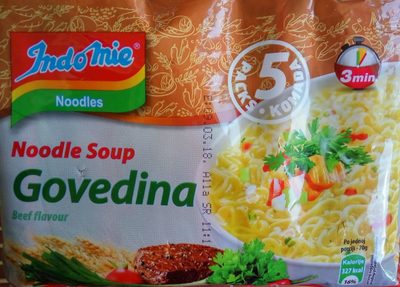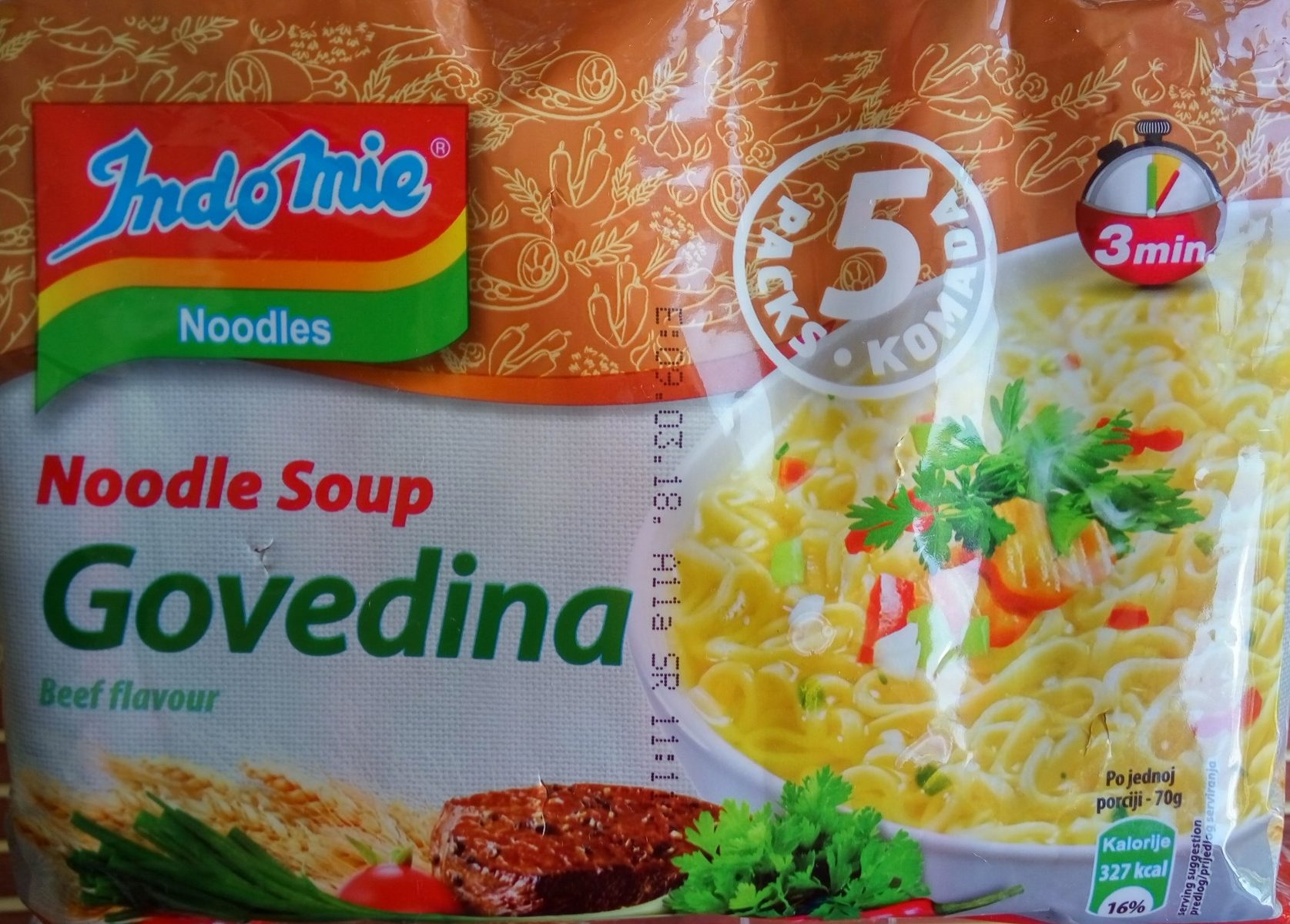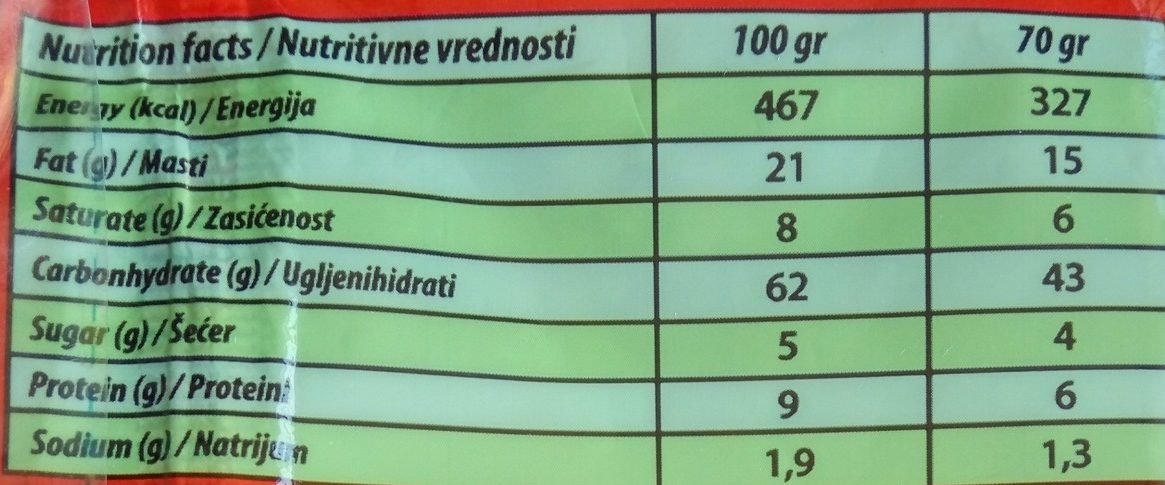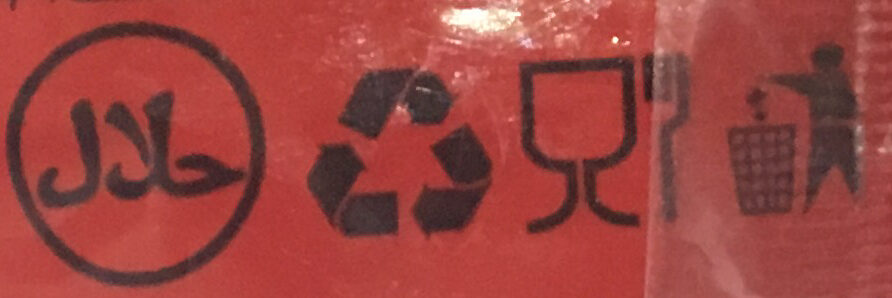Help us make food transparency the norm!
As a non-profit organization, we depend on your donations to continue informing consumers around the world about what they eat.
The food revolution starts with you!
Noodles - Beef Flavor - 5 Pack - Indomie - 350 g (5x70g)
Noodles - Beef Flavor - 5 Pack - Indomie - 350 g (5x70g)
This product page is not complete. You can help to complete it by editing it and adding more data from the photos we have, or by taking more photos using the app for Android or iPhone/iPad. Thank you!
×
Barkod: 0089686170085 (EAN / EAN-13) 089686170085 (UPC / UPC-A)
Common name: Instant nudle sa ukusom govedine
Količina: 350 g (5x70g)
Ambalaža: en:Plastic, en:pp-polypropylene, en:Bag
Брендови: Indomie
Категорије: en:Plant-based foods and beverages, en:Plant-based foods, en:Cereals and potatoes, en:Cereals and their products, en:Dried products, en:Pastas, en:Dried products to be rehydrated, en:Noodles, en:Instant noodles
Oznake, sertifikati, nagrade:
Halal
Mesto u kojem se proizvodi ili prerađuje: Serbia
Prodavnice: City Gross, Oliven Eksotisk Mat
Matching with your preferences
Health
Sastojci
-
29 ingredients
Nudle (64.70g): Pšenično brašno (72.37%), biljno ulje (sadrži antioksidans: tercijarni Butilhidrohinon), so, regulator kiselosti (kalijum-karbonat, natrijum-karbonat, dimatrijum-difosfat), zgušnjivač (guar guma), vitamin B2 (riboflavin) Začinska smeša (5.0g): so, šećer, aroma govedine, ekstrakt kvasca, biber, celer u prahu, beli luk u prahu, karamela, crni luk u prahu, limun aroma. Čili u prahu (0.3 g).Алергени: Celer, Pšenica
Food processing
-
Ultra processed foods
Elements that indicate the product is in the en:4 - Ultra processed food and drink products group:
- Адитив: E412
- Адитив: E452
- Адитив: E621 - Mononatrijum glutamat
- Ingredient: Zgušnjavači
Food products are classified into 4 groups according to their degree of processing:
- Neprerađena ili minimalno prerađena hrana
- Prerađeni kulinarski sastojci
- Prerađena hrana
- Ultra processed foods
The determination of the group is based on the category of the product and on the ingredients it contains.
Адитиви
-
E319
Tert-Butylhydroquinone: tert-Butylhydroquinone -TBHQ, tertiary butylhydroquinone- is a synthetic aromatic organic compound which is a type of phenol. It is a derivative of hydroquinone, substituted with a tert-butyl group.Source: Wikipedia (Енглески језик)
-
E330 - Limunska kiselina
Citric acid: Citric acid is a weak organic acid that has the chemical formula C6H8O7. It occurs naturally in citrus fruits. In biochemistry, it is an intermediate in the citric acid cycle, which occurs in the metabolism of all aerobic organisms. More than a million tons of citric acid are manufactured every year. It is used widely as an acidifier, as a flavoring and chelating agent.A citrate is a derivative of citric acid; that is, the salts, esters, and the polyatomic anion found in solution. An example of the former, a salt is trisodium citrate; an ester is triethyl citrate. When part of a salt, the formula of the citrate ion is written as C6H5O3−7 or C3H5O-COO-3−3.Source: Wikipedia (Енглески језик)
-
E412
Guar gum: Guar gum, also called guaran, is a galactomannan polysaccharide extracted from guar beans that has thickening and stabilizing properties useful in the food, feed and industrial applications. The guar seeds are mechanically dehusked, hydrated, milled and screened according to application. It is typically produced as a free-flowing, off-white powder.Source: Wikipedia (Енглески језик)
-
E500
Sodium carbonate: Sodium carbonate, Na2CO3, -also known as washing soda, soda ash and soda crystals, and in the monohydrate form as crystal carbonate- is the water-soluble sodium salt of carbonic acid. It most commonly occurs as a crystalline decahydrate, which readily effloresces to form a white powder, the monohydrate. Pure sodium carbonate is a white, odorless powder that is hygroscopic -absorbs moisture from the air-. It has a strongly alkaline taste, and forms a moderately basic solution in water. Sodium carbonate is well known domestically for its everyday use as a water softener. Historically it was extracted from the ashes of plants growing in sodium-rich soils, such as vegetation from the Middle East, kelp from Scotland and seaweed from Spain. Because the ashes of these sodium-rich plants were noticeably different from ashes of timber -used to create potash-, they became known as "soda ash". It is synthetically produced in large quantities from salt -sodium chloride- and limestone by a method known as the Solvay process. The manufacture of glass is one of the most important uses of sodium carbonate. Sodium carbonate acts as a flux for silica, lowering the melting point of the mixture to something achievable without special materials. This "soda glass" is mildly water-soluble, so some calcium carbonate is added to the melt mixture to make the glass produced insoluble. This type of glass is known as soda lime glass: "soda" for the sodium carbonate and "lime" for the calcium carbonate. Soda lime glass has been the most common form of glass for centuries. Sodium carbonate is also used as a relatively strong base in various settings. For example, it is used as a pH regulator to maintain stable alkaline conditions necessary for the action of the majority of photographic film developing agents. It acts as an alkali because when dissolved in water, it dissociates into the weak acid: carbonic acid and the strong alkali: sodium hydroxide. This gives sodium carbonate in solution the ability to attack metals such as aluminium with the release of hydrogen gas.It is a common additive in swimming pools used to raise the pH which can be lowered by chlorine tablets and other additives which contain acids. In cooking, it is sometimes used in place of sodium hydroxide for lyeing, especially with German pretzels and lye rolls. These dishes are treated with a solution of an alkaline substance to change the pH of the surface of the food and improve browning. In taxidermy, sodium carbonate added to boiling water will remove flesh from the bones of animal carcasses for trophy mounting or educational display. In chemistry, it is often used as an electrolyte. Electrolytes are usually salt-based, and sodium carbonate acts as a very good conductor in the process of electrolysis. In addition, unlike chloride ions, which form chlorine gas, carbonate ions are not corrosive to the anodes. It is also used as a primary standard for acid-base titrations because it is solid and air-stable, making it easy to weigh accurately.Source: Wikipedia (Енглески језик)
-
E500i - Натријум карбонат
Sodium carbonate: Sodium carbonate, Na2CO3, -also known as washing soda, soda ash and soda crystals, and in the monohydrate form as crystal carbonate- is the water-soluble sodium salt of carbonic acid. It most commonly occurs as a crystalline decahydrate, which readily effloresces to form a white powder, the monohydrate. Pure sodium carbonate is a white, odorless powder that is hygroscopic -absorbs moisture from the air-. It has a strongly alkaline taste, and forms a moderately basic solution in water. Sodium carbonate is well known domestically for its everyday use as a water softener. Historically it was extracted from the ashes of plants growing in sodium-rich soils, such as vegetation from the Middle East, kelp from Scotland and seaweed from Spain. Because the ashes of these sodium-rich plants were noticeably different from ashes of timber -used to create potash-, they became known as "soda ash". It is synthetically produced in large quantities from salt -sodium chloride- and limestone by a method known as the Solvay process. The manufacture of glass is one of the most important uses of sodium carbonate. Sodium carbonate acts as a flux for silica, lowering the melting point of the mixture to something achievable without special materials. This "soda glass" is mildly water-soluble, so some calcium carbonate is added to the melt mixture to make the glass produced insoluble. This type of glass is known as soda lime glass: "soda" for the sodium carbonate and "lime" for the calcium carbonate. Soda lime glass has been the most common form of glass for centuries. Sodium carbonate is also used as a relatively strong base in various settings. For example, it is used as a pH regulator to maintain stable alkaline conditions necessary for the action of the majority of photographic film developing agents. It acts as an alkali because when dissolved in water, it dissociates into the weak acid: carbonic acid and the strong alkali: sodium hydroxide. This gives sodium carbonate in solution the ability to attack metals such as aluminium with the release of hydrogen gas.It is a common additive in swimming pools used to raise the pH which can be lowered by chlorine tablets and other additives which contain acids. In cooking, it is sometimes used in place of sodium hydroxide for lyeing, especially with German pretzels and lye rolls. These dishes are treated with a solution of an alkaline substance to change the pH of the surface of the food and improve browning. In taxidermy, sodium carbonate added to boiling water will remove flesh from the bones of animal carcasses for trophy mounting or educational display. In chemistry, it is often used as an electrolyte. Electrolytes are usually salt-based, and sodium carbonate acts as a very good conductor in the process of electrolysis. In addition, unlike chloride ions, which form chlorine gas, carbonate ions are not corrosive to the anodes. It is also used as a primary standard for acid-base titrations because it is solid and air-stable, making it easy to weigh accurately.Source: Wikipedia (Енглески језик)
-
E501
Potassium carbonate: Potassium carbonate -K2CO3- is a white salt, which is soluble in water -insoluble in ethanol- and forms a strongly alkaline solution. It can be made as the product of potassium hydroxide's absorbent reaction with carbon dioxide. It is deliquescent, often appearing a damp or wet solid. Potassium carbonate is used in the production of soap and glass.Source: Wikipedia (Енглески језик)
-
E501i - Калијум карбонат
Potassium carbonate: Potassium carbonate -K2CO3- is a white salt, which is soluble in water -insoluble in ethanol- and forms a strongly alkaline solution. It can be made as the product of potassium hydroxide's absorbent reaction with carbon dioxide. It is deliquescent, often appearing a damp or wet solid. Potassium carbonate is used in the production of soap and glass.Source: Wikipedia (Енглески језик)
-
E621 - Mononatrijum glutamat
Monosodium glutamate: Monosodium glutamate -MSG, also known as sodium glutamate- is the sodium salt of glutamic acid, one of the most abundant naturally occurring non-essential amino acids. Glutamic acid is found naturally in tomatoes, grapes, cheese, mushrooms and other foods.MSG is used in the food industry as a flavor enhancer with an umami taste that intensifies the meaty, savory flavor of food, as naturally occurring glutamate does in foods such as stews and meat soups. It was first prepared in 1908 by Japanese biochemist Kikunae Ikeda, who was trying to isolate and duplicate the savory taste of kombu, an edible seaweed used as a base for many Japanese soups. MSG as a flavor enhancer balances, blends, and rounds the perception of other tastes.The U.S. Food and Drug Administration has given MSG its generally recognized as safe -GRAS- designation. A popular belief is that large doses of MSG can cause headaches and other feelings of discomfort, known as "Chinese restaurant syndrome," but double-blind tests fail to find evidence of such a reaction. The European Union classifies it as a food additive permitted in certain foods and subject to quantitative limits. MSG has the HS code 29224220 and the E number E621.Source: Wikipedia (Енглески језик)
Ingredients analysis
-
Палмино масло
Ingredients that contain palm oil: en:Refined palm oil
-
Статус вегана непознат
Unrecognized ingredients: en:sugar-flavor-enhancer, en:artificial-beef-flavor-powder, en:acidity-regularSome ingredients could not be recognized.
We need your help!
You can help us recognize more ingredients and better analyze the list of ingredients for this product and others:
- Edit this product page to correct spelling mistakes in the ingredients list, and/or to remove ingredients in other languages and sentences that are not related to the ingredients.
- Add new entries, synonyms or translations to our multilingual lists of ingredients, ingredient processing methods, and labels.
If you would like to help, join the #ingredients channel on our Slack discussion space and/or learn about ingredients analysis on our wiki. Thank you!
-
en:Vegetarian status unknown
Unrecognized ingredients: en:sugar-flavor-enhancer, en:artificial-beef-flavor-powder, en:acidity-regularSome ingredients could not be recognized.
We need your help!
You can help us recognize more ingredients and better analyze the list of ingredients for this product and others:
- Edit this product page to correct spelling mistakes in the ingredients list, and/or to remove ingredients in other languages and sentences that are not related to the ingredients.
- Add new entries, synonyms or translations to our multilingual lists of ingredients, ingredient processing methods, and labels.
If you would like to help, join the #ingredients channel on our Slack discussion space and/or learn about ingredients analysis on our wiki. Thank you!
-
Details of the analysis of the ingredients
We need your help!
Some ingredients could not be recognized.
We need your help!
You can help us recognize more ingredients and better analyze the list of ingredients for this product and others:
- Edit this product page to correct spelling mistakes in the ingredients list, and/or to remove ingredients in other languages and sentences that are not related to the ingredients.
- Add new entries, synonyms or translations to our multilingual lists of ingredients, ingredient processing methods, and labels.
If you would like to help, join the #ingredients channel on our Slack discussion space and/or learn about ingredients analysis on our wiki. Thank you!
en: Noodles 92% (WHEAT FLOUR), refined palm oil (contains antioxidant, tertiary butylhydroquinone), salt, acidity regulator (potassium carbonate, sodium carbonate, polyphosphates), thickener (guar gum), vitamins, vitamin b2, riboflavin, salt, sugar flavor enhancer (monosodium glutamate), artificial beef flavor powder, yeast extract, leek, pepper, celery powder, acidity regular (citric acid), garlic, caramel, onion, chili 0.4%- Noodles -> en:noodle - vegan: maybe - vegetarian: maybe - percent_min: 92 - percent: 92 - percent_max: 92
- WHEAT FLOUR -> en:wheat-flour - vegan: yes - vegetarian: yes - ciqual_proxy_food_code: 9410 - percent_min: 92 - percent_max: 92
- refined palm oil -> en:refined-palm-oil - vegan: yes - vegetarian: yes - from_palm_oil: yes - ciqual_food_code: 16150 - percent_min: 0.421052631578947 - percent_max: 0.799999999999998
- contains antioxidant -> en:antioxidant - percent_min: 0.210526315789474 - percent_max: 0.799999999999998
- tertiary butylhydroquinone -> en:e319 - vegan: yes - vegetarian: yes - percent_min: 0 - percent_max: 0.399999999999999
- salt -> en:salt - vegan: yes - vegetarian: yes - ciqual_food_code: 11058 - percent_min: 0.4 - percent_max: 0.778947368421053
- acidity regulator -> en:acidity-regulator - percent_min: 0.4 - percent_max: 0.778947368421048
- potassium carbonate -> en:e501i - vegan: yes - vegetarian: yes - percent_min: 0.133333333333333 - percent_max: 0.778947368421048
- sodium carbonate -> en:e500i - vegan: yes - vegetarian: yes - percent_min: 0 - percent_max: 0.389473684210524
- polyphosphates -> en:e452 - vegan: yes - vegetarian: yes - percent_min: 0 - percent_max: 0.259649122807016
- thickener -> en:thickener - percent_min: 0.4 - percent_max: 0.778947368421043
- guar gum -> en:e412 - vegan: yes - vegetarian: yes - percent_min: 0.4 - percent_max: 0.778947368421043
- vitamins -> en:vitamins - vegan: yes - vegetarian: yes - percent_min: 0.4 - percent_max: 0.778947368421037
- vitamin b2 -> en:e101 - vegan: maybe - vegetarian: yes - percent_min: 0.4 - percent_max: 0.778947368421032
- riboflavin -> en:e101 - vegan: maybe - vegetarian: yes - percent_min: 0.4 - percent_max: 0.778947368421027
- salt -> en:salt - vegan: yes - vegetarian: yes - ciqual_food_code: 11058 - percent_min: 0.4 - percent_max: 0.778947368421021
- sugar flavor enhancer -> en:sugar-flavor-enhancer - percent_min: 0.4 - percent_max: 0.647368421052627
- monosodium glutamate -> en:e621 - vegan: yes - vegetarian: yes - percent_min: 0.4 - percent_max: 0.647368421052627
- artificial beef flavor powder -> en:artificial-beef-flavor-powder - percent_min: 0.4 - percent_max: 0.530994152046779
- yeast extract -> en:yeast-extract - vegan: yes - vegetarian: yes - ciqual_proxy_food_code: 11009 - percent_min: 0.4 - percent_max: 0.530994152046778
- leek -> en:leek - vegan: yes - vegetarian: yes - ciqual_food_code: 20039 - percent_min: 0.4 - percent_max: 0.361722488038273
- pepper -> en:pepper - vegan: yes - vegetarian: yes - ciqual_proxy_food_code: 11015 - percent_min: 0.4 - percent_max: 0.361722488038272
- celery powder -> en:celery-powder - vegan: yes - vegetarian: yes - ciqual_proxy_food_code: 20055 - percent_min: 0.4 - percent_max: 0.298245614035082
- acidity regular -> en:acidity-regular - percent_min: 0.4 - percent_max: 0.298245614035082
- citric acid -> en:e330 - vegan: yes - vegetarian: yes - percent_min: 0.4 - percent_max: 0.298245614035082
- garlic -> en:garlic - vegan: yes - vegetarian: yes - ciqual_food_code: 11000 - percent_min: 0.4 - percent_max: 0.158596491228065
- caramel -> en:e150 - vegan: yes - vegetarian: yes - percent_min: 0.4 - percent_max: 0.123684210526311
- onion -> en:onion - vegan: yes - vegetarian: yes - ciqual_food_code: 20034 - percent_min: 0.4 - percent_max: 0.12368421052631
- chili -> en:chili-pepper - vegan: yes - vegetarian: yes - ciqual_food_code: 20151 - percent_min: 0.4 - percent: 0.4 - percent_max: 0.12368421052631
Nutritivne vrednosti
-
Hranljiva vrednost
Hranljiva vrednost As sold
for 100 g / 100 mlAs sold
per serving (70g)Compared to: en:Pastas Енергија 1.860 kj
(442 kcal)1.300 kj
(309 kcal)+29% Масти 15 g 10,5 g +698% Zasićena mast 7 g 4,9 g +864% Carbohydrates 65 g 45,5 g -4% Шећер 6 g 4,2 g +97% Fiber 3 g 2,1 g +1% Протеин 10 g 7 g -14% Со 3,8 g 2,66 g +4.674% Fruits‚ vegetables‚ nuts and rapeseed‚ walnut and olive oils (estimate from ingredients list analysis) 0,73 % 0,73 %
Environment
-
Eco-Score C - Moderate environmental impact
The Eco-Score is an experimental score that summarizes the environmental impacts of food products.→ The Eco-Score was initially developped for France and it is being extended to other European countries. The Eco-Score formula is subject to change as it is regularly improved to make it more precise and better suited to each country.Life cycle analysis
-
Average impact of products of the same category: A (Score: 82/100)
Категорија: Asian noodles, flavoured, dehydrated
Категорија: Asian noodles, flavoured, dehydrated
- PEF environmental score: 0.26 (the lower the score, the lower the impact)
- including impact on climate change: 1.66 kg CO2 eq/kg of product
Stage Impact Agriculture
65.2 %Processing
20.8 %Ambalaža
8.7 %Transportation
3.5 %Distribution
1.8 %Consumption
0.0 %
Bonuses and maluses
-
Missing origins of ingredients information
Malus: -5
⚠ ️ The origins of the ingredients of this product are not indicated.
If they are indicated on the packaging, you can modify the product sheet and add them.
If you are the manufacturer of this product, you can send us the information with our free platform for producers.
-
Ingredients that threatens species
Malus: -10
Contains palm oil
Tropical forests in Asia, Africa and Latin America are destroyed to create and expand oil palm tree plantations. The deforestation contributes to climate change, and it endangers species such as the orangutan, the pigmy elephant and the Sumatran rhino.
-
Packaging with a high impact
Malus: -15
Shape Material Recycling Impact 5 Bag PP 5 - полипропилен Recycle with plastics Високо 1 Wrapper PP 5 - полипропилен Recycle with plastics Високо 5 Wrapper 90 C/X Discard Високо ⚠ ️ The information about the packaging of this product is not sufficiently precise (exact shapes and materials of all components of the packaging).⚠ ️ For a more precise calculation of the Eco-Score, you can modify the product page and add them.
If you are the manufacturer of this product, you can send us the information with our free platform for producers.
Eco-Score for this product
-
Impact for this product: C (Score: 52/100)
Производ: Noodles - Beef Flavor - 5 Pack - Indomie - 350 g (5x70g)
Life cycle analysis score: 82
Sum of bonuses and maluses: -30
Final score: 52/100
-
Carbon footprint
-
Equal to driving 0.9 km in a petrol car
166 g CO² per 100g of product
The carbon emission figure comes from ADEME's Agribalyse database, for the category: Asian noodles, flavoured, dehydrated (Source: ADEME Agribalyse Database)
Stage Impact Agriculture
60.9 %Processing
14.9 %Ambalaža
16.3 %Transportation
6.9 %Distribution
1.0 %Consumption
0.0 %
Ambalaža
-
Packaging with a high impact
-
Packaging parts
5 x Wrapper (90 C/X: 0.15 g)
5 x Bag (PP 5 - полипропилен: 1.7 g)
1 x Wrapper (PP 5 - полипропилен: 3.6 g)
-
Packaging materials
Material % Packaging weight Packaging weight per 100 g of product Plastic 94.2% 12.1 g 3.5 g
-
Transportation
-
Origins of ingredients
Missing origins of ingredients information
⚠ ️ The origins of the ingredients of this product are not indicated.
If they are indicated on the packaging, you can modify the product sheet and add them.
If you are the manufacturer of this product, you can send us the information with our free platform for producers.Add the origins of ingredients for this product Add the origins of ingredients for this product
Threatened species
-
Contains palm oil
Drives deforestation and threatens species such as the orangutan
Tropical forests in Asia, Africa and Latin America are destroyed to create and expand oil palm tree plantations. The deforestation contributes to climate change, and it endangers species such as the orangutan, the pigmy elephant and the Sumatran rhino.
Report a problem
-
Incomplete or incorrect information?
Category, labels, ingredients, allergens, nutritional information, photos etc.
If the information does not match the information on the packaging, please complete or correct it. Open Food Facts is a collaborative database, and every contribution is useful for all.
Data sources
Product added on од bojackhorseman
Last edit of product page on од odinh.
Страницу производа такође уредио akitainu, aleene, ecoscore-impact-estimator, fix-salt-bot, halal-app-chakib, kiliweb, openfoodfacts-contributors, packbot, tacite-mass-editor, yaako9, yuka.UW9rYlBQUmR2cVl0cHRvbTVBR0krc05UMzhXR2JYK0xLTW8xSVE9PQ.










